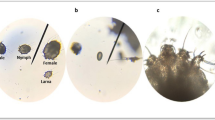Abstract
We describe and analyze a mathematical model for schistosomiasis in which infected snails are distinguished from susceptible through increased mortality and no reproduction. We based the model on the same derivation as Anderson and May (J. Anim. Ecol. 47:219–247, 1978), Feng and Milner (A New Mathematical Model of Schistosomiasis, Mathematical Models in Medical and Health Science, Nashville, TN, 1997. Innov. Appl. Math., Vanderbilt Univ. Press, Nashville, pp. 117–128, 1998), and May and Anderson (J. Anim. Ecol. 47:249–267, 1978), but used logistic growth both in human and snail hosts. We introduce a parameter r, the effective coverage of medical treatment/prevention to control the infection. We determine a reproductive number for the disease directly related to its persistence and extinction. Finally, we obtain a critical value for r that indicates the minimum treatment effort needed in order to clear out the disease from the population.
Similar content being viewed by others
References
Adler, F.R., Kretzschmar, M., 1992. Aggregation and stability in parasite-host models. Parasitology 104, 199–05.
Anderson, R.M., 1978. The regulation of host population growth by parasitic species. Parasitology 76, 119–58.
Anderson, R.M., May, R.M., 1978. Regulation and stability of host-parasite populations interactions: I. Regulatory processes. J. Anim. Ecol. 47, 219–47.
Anderson, R.M., May, R.M., 1979. Prevalence of schistosome infections within molluscan populations: Observed patterns and theoretical predictions. Parasitology 79, 63–4.
Anderson, R.M., May, R.M., 1985. Helminth infections of humans: Mathematical models, population dynamics, and control. Adv. Parasitol. 24, 1–01.
Cohen, J.E., 1977. Mathematical models of schistosomiasis. Ann. Rev. Ecol. Syst. 8, 209–33.
Dobson, A.P., 1988. The population biology of parasite-induced changes in host behavior. Q. Rev. Biol. 63, 139–65.
Dummit, D.S., Foote, R.M., 1991. Abstract Algebra. Englewood Cliffs, Prentice Hall.
Feng, Z., Milner, F.A., 1998. A New Mathematical Model of Schistosomiasis, Mathematical Models in Medical and Health Science, Innov. Appl. Math., pp. 117–28. Nashville, TN, 1997. Vanderbilt Univ. Press, Nashville.
Feng, Z., Li, C.-C., Milner, F.A., 2002. Schistosomiasis models with density dependence and age of infection in snail dynamics, Deterministic and stochastic modeling of biointeraction. Math. Biosci. 177/178, 271–86.
Feng, Z., Eppert, A., Milner, F.A., Minchella, D.J., 2004. Estimation of parameters governing the transmission dynamics of schistosomes. Appl. Math. Lett. 17(10), 1105–112.
Gérard, C., Théron, A., 1997. Age/size- and time-specific effects of Schistosoma mansoni on energy allocation patterns of its snail host Biomphalaria glabrata. Oecologia 112, 447–52.
Jordan, P., Webbe, G., Sturrock, R., 1993. Human Schistosomiasis. CAB, Wallingford.
Kretzschmar, M., Adler, F., 1993. Aggregated distributions in models for patchy populations. Theor. Popul. Biol. 43, 1–0.
Kostizin, V.A., 1934. Symbiose, Parasitisme et Évolution. Étude Mathématique, pp. 369–08. Hermann, Paris. Translated in Scudo, F., Ziegler, J. (Eds.), The Golden Age of Theoretical Ecology. Lectures Notes in Biomathematics, vol. 52. Springer, Berlin, 1978.
MacDonald, G., 1965. The dynamics of helminth infections, with special reference to schistosomiasis. Trans. R. Soc. Trop. Med. Hyg. 59, 489–06.
May, R.M., Anderson, R.M., 1978. Regulation and stability of host-parasite populations interactions II. J. Anim. Ecol. 47, 249–67.
Milner, F.M., Zhao, R., 2008. A mathematical model of schistosomiasis with spatial structure. Math. Biosci. Eng. 5, 505–22.
Nåsell, I., 1976. A hybrid model of schistosomiasis with snail latency. Theor. Popul. Biol. 10, 47–9.
Pugliese, A., Rosà, R., Damaggio, M.L., 1998. Analysis of a model for macroparasitic infection with variable aggregation and clumped infection. J. Math. Biol. 36, 419–47.
Rosà, R., Pugliese, A., 2002. Aggregation, stability, and oscillations in different models for host-macroparasite interactions. Theor. Popul. Biol. 61, 319–34.
Rosà, R., Pugliese, A., Villani, A., Rizzoli, A., 2003. Individual-based vs. deterministic models for macroparasites: host cycles and extinction. Theor. Popul. Biol. 63, 295–07.
Ross, A.G.P., Bartley, P.B., Sleign, A.C., Olds, R.R., Li, Y., Williams, G.M., McManus, D.P., 2002. Schistosomiasis. N. Engl. J. Med. 346, 1212–220.
Sorensen, R.E., Minchella, D.J., 2001. Snail-trematode life history interactions: past trends and future directions. Parasitology 123, S3–S18.
Sturrock, B.M., 1966. The influence of infection with Schistosoma mansoni on the growth rate and reproduction of Biomphalaria pfeifferi. Ann. Trop. Med. Parasitol. 60, 187–97.
Théron, A., 1981. Dynamics of larval populations of Schistosoma mansoni in Biomphalaria glabrata: I—Rhythmic production of cercariae in monomiracidial infections. Ann. Trop. Med. Parasitol. 75(1), 71–7.
Théron, A., 1985. Dynamics of the cercarial production of Schistosoma mansoni in relation with the miracidial dose exposure to the snail host Biomphalaria glabrata. Ann. Parasitol. Hum. Comp. 60, 665–74.
Zhang, P., Feng, Z., Milner, F.A., 2007. Mathematical models of schistosomiasis with an age structure in the human host. Math. Biosci. 205, 83–07.
World Health Organization: http://www.who.int/schistosomiasis/en/, available on September, 2007
World Health Organization: The control of schistosomiasis. Second report of WHO expert committee. WHO Technical Report Series, No. 830, Geneva (1993)
Author information
Authors and Affiliations
Corresponding author
Rights and permissions
About this article
Cite this article
Zhao, R., Milner, F.A. A Mathematical Model of Schistosoma mansoni in Biomphalaria glabrata with Control Strategies. Bull. Math. Biol. 70, 1886–1905 (2008). https://doi.org/10.1007/s11538-008-9330-5
Received:
Accepted:
Published:
Issue Date:
DOI: https://doi.org/10.1007/s11538-008-9330-5




